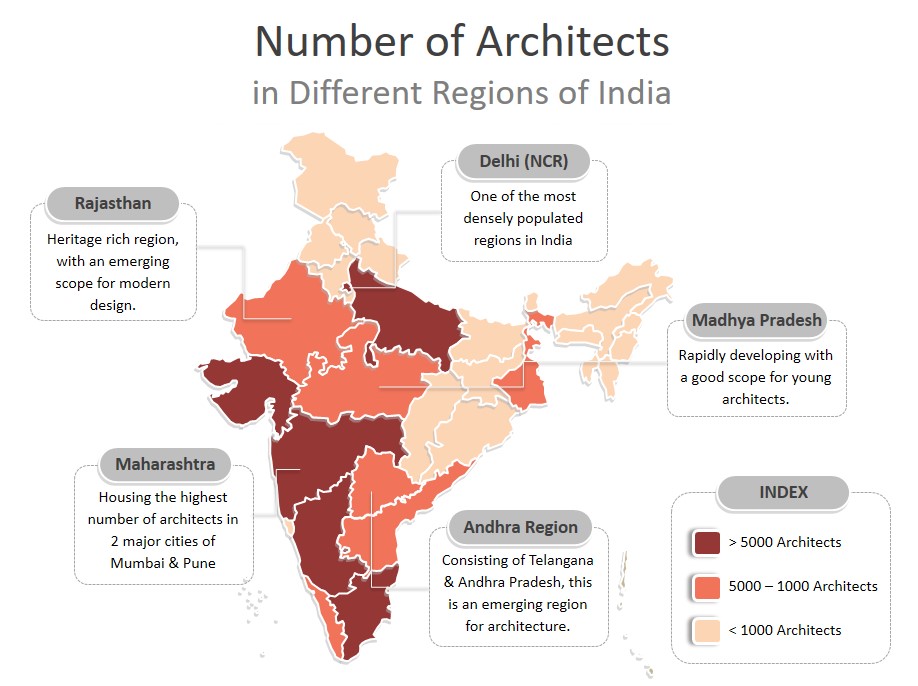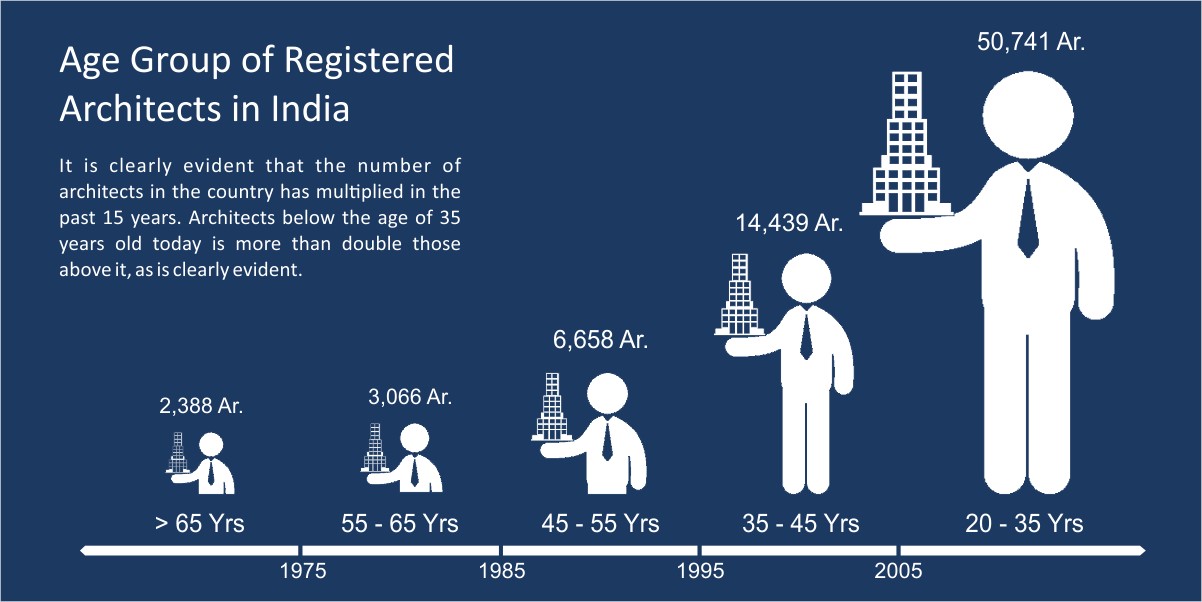
“As an architect you design for the present, with an awareness of the past, for a future which is essentially unknown.” – Norman Foster
Evolving times require evolving resources. And the times, are always evolving. Architecture is one of the mediums through which we alter our environment to better fit our current needs. Making it an ever-lasting and ever-evolving profession. Therefore, it is a good career choice for the creative logical thinkers and problem solvers.
Architecture has many prospects and directions for professional growth. After pursuing a five year Bachelors of Architecture (B.Arch) degree or diploma, one is all-set to kick start with their architecture career. Post that, a graduate can choose to further specialise in a field such as sustainable architecture, technical architecture etc. by pursuing a Masters of Architecture (M.Arch) degree. Or he/she can choose to practice professionally by getting a job, or even by starting-up their own studio. While it is recommended to take up a job and gain some practical experience in the field, some individuals choose to start-up early, depending on their circumstances.
India has been at the forefront of good architecture from early days, as is represented by our heritage monuments. Being a developing country, India’s infrastructure is also growing at a fast-pace. Accelerated urbanisation means a growing requirement of architectural development. With a growth in the number of Government commissioned infrastructural projects as well as the growing requirement of housing facilities, a boon in the field of architecture can be easily projected.
Upcoming Prospects
The Indian Government in its Development Agenda has outlined the development of 100 smart cities, 40 million dwelling units, 20 million affordable homes, and better infrastructure facilities through the AMRUT scheme. Along with a thrust towards urban development and transformation, slum rehabilitation and has also committed to housing for all by 2022. A growing requirement for architects can be seen in the developing towns and cities that are rapidly becoming metropolitans. Cities such as Pune, Surat, Hyderabad, Bhopal, Lucknow, Jaipur, Chandigarh, Mysore, Kochi, Raipur and Guwahati are amongst the many rapidly developing cities in the country.

Along with the government, many private institutions are also recognising the importance of architects in shaping our future on the planet. With the growing focus on specialisations such as sustainable architecture, and with the developing architectural technology such as the integration of AI, we can clearly view the major role of architects in shaping our future. Such is the forecast for the increasing scope of the profession in the coming years.
Post-Covid India
But while the overall scope is promising, the recent pandemic has hit the Indian economy pretty hard, along with the rest of the world. Lockdown of business activity has resulted in an economic slump that shall require at least a couple of years to recover. This paralysation of trade has resulted in a shortfall of liquidity with companies, resulting in a slowdown in building and construction, as well.
While the clients do not have money to spend on construction, innovation is at a peak with material and product vendors coming up with newer ideas in an effort to make a sale during this crisis. This pandemic has also resulted in an increased focus on a more innovative and self-reliant design approach, keeping in line with the social-distancing guidelines. Many architects believe that a revolution in space design can be clearly foreseen. A clear shift towards a more self-sufficient living style along with more eco-friendly methods of production and material usage is evident. Soon sustainable architecture shall become a necessity, which young architects must adapt to. A forthcoming requirement for green designers and urban architects can thus be predicted.
Current Statistics
Let us now take a look at some current statistics to gauge a clearer picture of the practical factors affecting a young architect in India. The total number of active architects registered in the country today are a little short of a 100,000, as per the 2020 statistics of the Council of Architecture (COA), India. Out of this, about 52.94% are male and 47.o6% are female architects. Out of the total, more that 50% of the architects are concentrated in just 30 cities of the nation. About 50% of architects are currently employed in the private sector, while the remaining 50% are distributed between practicing individually, not practising or are in employment with the government.
As the numbers suggest, while architecture has plenty of scope, there is also steep competition in the field. This steep competition is what makes earning a living challenging for a young architect. We conducted a survey of young architects and found that, in India, most young architects receive a monthly salary of about 15k (approx. $200) for the first couple of years of their career. Thus, making it impractical for them to migrate to bigger cities in the country, as the cost of living there is higher and sustenance is difficult with this meagre pay scale. It takes about 5-6 years’ experience for an architect to be able to establish themselves and earn a decent living in India. This is one of the reasons why many young architects choose to set-up their own practice. Yet, there are many who manage to slug it through the initial years to grow exponentially in their jobs later on.
While the scope of the field is huge, the number of practising architects is also increasing many-fold. There have been twice as many registrations of architects in India in the past decade, compared to the decade before that. This can be attributed to the growing number of architectural institutes in the country, which some believe is also resulting in a decline in the quality of architectural education in India.

This is regulated by the Council of Architecture (COA) in India. One must be registered with the COA to practice architecture in India. Qualifications required for registration as specified by the Architects Act, 1972 are as follows:
- A recognized architectural degree or diploma.
- Resides in India.
- If he/she is not an Indian, but is engaged in the practice for not less than 5 years.
- Possesses other qualifications that certify his application for registration, as specified by the most recent amendment of the above mentioned Act.
As per these guidelines, foreign nationals are not eligible to practice architecture in India, individually. But an expatriate can get a job with an Indian architecture company or construction firm and work here. International architects and architecture firms have also been known to collaborate with local construction companies or architecture firms, wherein they officially take up the role of design consultant, while the local company is the facilitator of the whole project.
Foreign Architects in India
One such example of a spectacle of modern architecture in India is the Chhatrapati Shivaji International Airport – Terminal 2 in Mumbai. This beautiful structure was designed by the international architecture firm SOM in collaboration with GVK India in 2014.
In the past years, many international architects have taken an interest in India as a developing country with the space and opportunity for architectural innovation and development. “Architectural opportunity is far greater in India today, compared to many other countries. The developed nations are over built, there’s less scope to be creative and there are fewer projects. India on the other hand, is on a building spree,” reasons Manit Rastogi, director of Morphogenesis Architecture Studio. This Indian firm has attracted many young architects from countries as diverse as Norway, Sweden, France and UK.
In fact, some Indian Architecture firms prefer expats and foreign graduates for design and development roles, such as M Moser Associates, based in Bangalore. Some believe that international education exposes a designer to newer concepts, and provides them with a broader perspective of the world.
Another example of this can be the many established Indian architects who had completed their education from Ivy League schools abroad, and are now leaders of the industry in India. Starting from the highly renowned Lt. Charles Correa to the esteemed Rahul Mehrotra of RMA Architects to the inspiring Rooshad Shroff with his own studio in Mumbai, India has witnessed many great architects who studied abroad and have taken the industry by storm.
One recent benefit for foreign nationals is the convenient E- Business Visa that is valid for a year. You can apply for this visa online and upon approval, it shall be stamped onto your passport at immigration. The visa would be valid for 365 days from the date of approval, with a permission to stay for 180 days at a stretch in the country. If you wish to stay longer than 180 days at a stretch, you can register with the FRRO/FRO office. If you wish to work for more than a year, a regular visa can be applied for at any Indian Visa Application Centre. The validity of a regular visa is subject to your application.
Job Opportunities
So, if you are an aspiring young architect and would like explore job opportunities in India, let’s look at your prospects. According to our survey, there are three popular ways of finding a job in India:
- Online Job Websites/ Job Boards
- Personal Emails to Companies
- References & Connections
Let’s explore these three.
Job websites and job boards are an effective way to find available opportunities to pursue. We found three websites, which are currently the most popular among architecture graduates. These are:
Jobs.archi: A specialised portal for architecture jobs globally, jobs.archi is a popular international job board that features architecture job openings worldwide. It links recent architecture graduates to the right job vacancies in the countries of their choice.
LinkedIn: This popular networking website is one of the most preferred ways to find a job for the Indian youth. The website not only exhibits job listings, but also displays the attributes of the applicants to the recruiters. Hence, making the hiring process easy for all. It provides a good combination of building connections and finding opportunities.
Naukri: This Indian job portal focuses on serving the local market primarily. Since it has marketed itself well within the country, it is the second most popular website for finding a job.
Monster Jobs: The Indian counterpart of this global job portal is the third most popular website for Indian graduates and recruiters. Being an international company provides a wider reach of job opportunities to the applicants.
One of the newer trends in job hunting and marketing in India, is the use of social media platforms, such as Instagram and Facebook. Many growing businesses advertise job opportunities through their social media handles to increase their reach amongst youth. Millennials find it convenient to find new work opportunities through their preferred medium of socialising.
While the three listed above are the most popular Job Portals, there are also specialised job boards such as ArchiJobs, which specialises in job listings of architecture in India. It has the added advantage of displaying job vacancies issued by the Government of India. Another such specialised portal is Micheal Page, which specialises in high profile job listings for expats and foreign nationals.
While job boards are a good way to find jobs with more established and structured firms, if you’re pursuing architecture for creativity, newer design studios might be the way to go. Architecture studios tend to be more focussed on creativity and innovation. Often such studios, comprise of a smaller group of multi-faceted people who manage different job profiles simultaneously and run the business as a team. It is usually a more preferable environment for learning, as one gets to experience the whole process of designing and execution at close quarters. One gains insight and experience into the nitty-gritties of the profession. It is often a more flexible and friendly work environment.
While design studios are great for early experiences, they often do not tend to put up job vacancies on the different job portals or websites. If you’re looking to work in a studio environment, it is better to research on the companies out there and apply for jobs through email. Studios are always on the look-out for newer talent and if your interests match, it could be a great learning experience.
As with most industries in India, references are another established way to secure a job. It is easier for individuals to trust employees who have references from someone they trust. So, it is easier to secure a job opening when you are being recommended by a college professor or even a relative that the employer trusts. Sadly, nepotism is a reality of most sectors, at least in India. Often, it is found that Architects also prefer hiring graduates from their Alma Mater or from schools they have hired from before, as their design philosophy is more likely to sync well.
It is also likely that a student might be offered a permanent position in a company, at the end of an internship with the firm. Or that an internship offer precede the commitment of a permanent position. This is beneficial for both the employer and employee, as it gives both time to understand the other and see if it’s the right fit.
Another trend in architectural employment in India is for young architects to join studio environments only for a couple of years to learn and grow and then to move on to other endeavours. This proves beneficial for both the studio as well as the architect, as the studio does not have to worry about salary increments and can hire fresh talent every couple years, and the architect gains the learning and the experience required for further practice of the profession.
While these are some of the highlights of the Architecture Profession in India, as with most subjects in this country, this subject also has many facets and intricacies that inter-connectedly influence each other. These are better understood with experience.
Please share your thoughts and experiences in the comments section below. Keep exploring and experiencing.
By Amrasha Bafna







